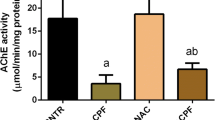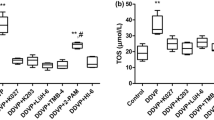Abstract
This study was designed to investigate the effects of amlodipine (AM), a dihydropyridine calcium channel blocker, on the oxidative damage induced by diazinon (DZN) in the rat cortex and cerebellum. Forty-two rats were randomly divided into six groups. The rats were treated intraperitoneally with normal saline (group 1), AM (9 mg/kg; group 2), DZN (32 mg/kg; group 3) and different doses of AM (3, 6, and 9 mg/kg; groups 4, 5, and 6, respectively) with DZN. After 14 days, the cerebellum and cortex tissues were removed for biochemical and histological experiments. DZN significantly decreased acetylcholinesterase activity (AChE; 57%, p < 0.001 and 39.1%, p < 0.05), depleted total antioxidant capacity (TAC; 46.2%, p < 0.01 and 44.7%, p < 0.05), and increased lactate dehydrogenase activity (LDH; 96%, p < 0.001 and 202%, p < 0.001), nitric oxide (NO; 130%, p < 0.001 and 74.4%, p < 0.001), and lipid peroxidation levels (LPO; 35.6%, p < 0.001 and 128.7%, p < 0.001), in the cerebellum and cortex tissues, respectively. In addition, DZN induced structural alterations in the cerebellum and cortex. Following AM administration, a remarkable improvement was observed in LDH activity and some of the oxidative markers, such as NO and LPO; however, no significant changes were found in AChE activity when the DZN group was compared with the AM-treated groups. This study suggests that AM may prevent DZN-induced neurotoxicity via improvement of the oxidative/antioxidant balance in the cerebellum and cortex tissues.






Similar content being viewed by others
References
Gudienė D, Burba B. Mental disorders and their relation to brain lesion location: diagnostical problems. Medicina (Kaunas). 2003;39:114–21.
Bugeon S, Lafi S, Beurrier C, Sahu S, Runge K, Schaller F, et al. Morphofunctional deficits in the cerebral cortex of NeuroD2 mutant mice are associated with autism/schizophrenia-like behaviors. BioRxiv: 2018:296889.
Fenlon LR, Liu S, Gobius I, Kurniawan ND, Murphy S, Moldrich RX, et al. Formation of functional areas in the cerebral cortex is disrupted in a mouse model of autism spectrum disorder. Neural Dev. 2015;10:10.
Herzfeld DJ, Pastor D, Haith AM, Rossetti Y, Shadmehr R, O’shea J. Contributions of the cerebellum and the motor cortex to acquisition and retention of motor memories. Neuroimage. 2014;98:147–58.
Sankhwar ML, Yadav RS, Shukla RK, Pant AB, Singh D, Parmar D, et al. Impaired cholinergic mechanisms following exposure to monocrotophos in young rats. Hum Exp Toxicol. 2012;31:606–16.
Yadav S, Singh M, Yadav R. Organophosphates induced Alzheimer’s disease: an epigenetic aspect. J Clin Epigenet. 2016;2:1158–2472.
Sankhwar ML, Yadav RS, Shukla RK, Singh D, Ansari RW, Pant AB, et al. Monocrotophos induced oxidative stress and alterations in brain dopamine and serotonin receptors in young rats. Toxicol Ind Health. 2016;32:422–36.
Nili-Ahmadabadi A, Alibolandi P, Ranjbar A, Mousavi L, Nili-Ahmadabadi H, Larki-Harchegani A, et al. Thymoquinone attenuates hepatotoxicity and oxidative damage caused by diazinon: an in vivo study. Res Pharm Sci. 2018;13:500–8.
Hassani S, Maqbool F, Salek-Maghsoudi A, Rahmani S, Shadboorestan A, Nili-Ahmadabadi A, et al. Alteration of hepatocellular antioxidant gene expression pattern and biomarkers of oxidative damage in diazinon-induced acute toxicity in Wistar rat: a time-course mechanistic study. EXCLI J. 2018;17:57–71.
Nili-Ahmadabadi A, Ali-Heidar F, Ranjbar A, Mousavi L, Ahmadimoghaddam D, Larki-Harchegani A, et al. Protective effect of amlodipine on diazinon-induced changes on oxidative/antioxidant balance in rat hippocampus. Res Pharm Sci. 2018;13:368–76.
Magi S, Castaldo P, Macrì ML, Maiolino M, Matteucci A, Bastioli G, et al. Intracellular calcium dysregulation: implications for Alzheimer’s disease. Biomed Res Int 2016. https://doi.org/10.1155/2016/6701324.
Saternos HC, AbouAlaiwi WA. Signaling interplay between primary cilia and nitric oxide: a mini review. Nitric Oxide 2018;80:108–12.
Nili-Ahmadabadi A, Pourkhalili N, Fouladdel S, Pakzad M, Mostafalou S, Hassani S, et al. On the biochemical and molecular mechanisms by which malathion induces dysfunction in pancreatic islets in vivo and in vitro. Pestic Biochem Physiol. 2013;106:51–60.
Pronobesh C, Dagagi A, Pallab C, Kumar W. Protective role of the calcium channel blocker amlodipine against mitochondrial injury in ischemia and reperfusion injury of rat liver. Acta Pharm. 2008;58:421–8.
Fares H, DiNicolantonio JJ, O’Keefe JH, Lavie CJ. Amlodipine in hypertension: a first-line agent with efficacy for improving blood pressure and patient outcomes. Open Heart. 2016;3:e000473.
Ritz B, Rhodes SL, Qian L, Schernhammer E, Olsen JH, Friis S. L-type calcium channel blockers and Parkinson disease in Denmark. Ann Neurol. 2010;67:600–6.
Zhao Q, Wang X, Chen A, Cheng X, Zhang G, Sun J, et al. Rhein protects against cerebral ischemic-/reperfusion-induced oxidative stress and apoptosis in rats. Int J Mol Med. 2018;41:2802–12.
Ozarowski M, Mikolajczak PL, Piasecka A, Kujawski R, Bartkowiak-Wieczorek J, Bogacz A, et al. Effect of Salvia miltiorrhiza root extract on brain acetylcholinesterase and butyrylcholinesterase activities, their mRNA levels and memory evaluation in rats. Physiol Behav. 2017;173:223–30.
Nili-Ahmadabadi A, Tavakoli F, Hasanzadeh G, Rahimi H, Sabzevari O. Protective effect of pretreatment with thymoquinone against Aflatoxin B1 induced liver toxicity in mice. Daru. 2011;19:282–7.
Zeinvand-Lorestani H, Nili-Ahmadabadi A, Balak F, Hasanzadeh G, Sabzevari O. Protective role of thymoquinone against paraquat-induced hepatotoxicity in mice. Pestic Biochem Physiol. 2018;148:16–21.
Judge SJ, Savy CY, Campbell M, Dodds R, Gomes LK, Laws G, et al. Mechanism for the acute effects of organophosphate pesticides on the adult 5-HT system. Chem Biol Interact. 2016;245:82–9.
Yadav RS. Biomarkers: an essential gizmo in pesticide toxicity. Biomarkers. 2016;2:9.
Garbarino VR, Orr ME, Rodriguez KA, Buffenstein R. Mechanisms of oxidative stress resistance in the brain: lessons learned from hypoxia tolerant extremophilic vertebrates. Arch Biochem Biophys. 2015;576:8–16.
Fischer GW, Torrillo TM, Weiner MM, Rosenblatt MA. The use of cerebral oximetry as a monitor of the adequacy of cerebral perfusion in a patient undergoing shoulder surgery in the beach chair position. Pain Pract. 2009;9:304–7.
Afolabi O, Sulaiman O, Adeleke G, Wusu D. Acetylcholinesterase activity and oxidative stress indices in cerebellum, cortex and hippocampus of rats exposed to lead and manganese. Int J Bio Res. 2016;4:157–64.
Kazi AI, Oommen A. Monocrotophos induced oxidative damage associates with severe acetylcholinesterase inhibition in rat brain. Neurotoxicology. 2012;33:156–61.
Cemek M, Büyükokuroğlu ME, Büyükben A, Aymelek F, Özcan L. Effects of vitamin E and selenium on tissue bio-element status in organophosphate toxicity of rats. Pestic Biochem Physiol. 2010;98:9–18.
Godfraind T, Salomone S. Ambiguities in dietary antioxidant supplementation compared to calcium channel blockers therapy. Front Pharmacol. 2015;6:10.
Chen Y. Organophosphate-induced brain damage: mechanisms, neuropsychiatric and neurological consequences, and potential therapeutic strategies. Neurotoxicology. 2012;33:391–400.
Liu Z, Zhou T, Ziegler AC, Dimitrion P, Zuo L. Oxidative stress in neurodegenerative diseases: from molecular mechanisms to clinical applications. Oxid Med Cell Longev. 2017;2017:2525967.
Hirooka Y, Kimura Y, Nozoe M, Sagara Y, Ito K, Sunagawa K. Amlodipine-induced reduction of oxidative stress in the brain is associated with sympatho-inhibitory effects in stroke-prone spontaneously hypertensive rats. Hypertens Res. 2006;29:49–56.
Sendrowski K, Rusak M, Sobaniec P, Ilendo E, Dabrowska M, Bockowski L, et al. Study of the protective effect of calcium channel blockers against neuronal damage induced by glutamate in cultured hippocampal neurons. Pharmacol Rep. 2013;65:730–6.
Förstermann U, Sessa WC. Nitric oxide synthases: regulation and function. Eur Heart J. 2011;33:829–37.
Moylan S, Berk M, Dean OM, Samuni Y, Williams LJ, O’neil A, et al. Oxidative and nitrosative stress in depression: why so much stress? Neurosci Biobehav Rev. 2014;45:46–62.
Abdel-Salam OM, Youness ER, Mohammed NA, Yassen NN, Khadrawy YA, El-Toukhy SE, et al. Nitric oxide synthase inhibitors protect against brain and liver damage caused by acute malathion intoxication. Asian Pac J Trop Med. 2017;10:773–86.
Pearson JN, Patel M. The role of oxidative stress in organophosphate and nerve agent toxicity. Ann N Y Acad Sci. 2016;1378:17–24.
Karami-Mohajeri S, Abdollahi M. Mitochondrial dysfunction and organophosphorus compounds. Toxicol Appl Pharmacol. 2013;270:39–44.
Mamou Z, Chahine M, Rhondali O, Dehina L, Chevalier P, Descotes J, et al. Effects of amlodipine and perindoprilate on the structure and function of mitochondria in ventricular cardiomyocytes during ischemia-reperfusion in the pig. Fundam Clin Pharmacol. 2015;29:21–30.
Acknowledgements
This work was financially supported (Grant No. 9412187262) by the Vice-chancellor of Research and Technology, Hamadan University of Medical Sciences, Hamadan, Iran.
Author information
Authors and Affiliations
Corresponding author
Ethics declarations
Conflict of interest
The authors declare that there is no conflict of interest.
Additional information
Publisher's Note
Springer Nature remains neutral with regard to jurisdictional claims in published maps and institutional affiliations.
Rights and permissions
About this article
Cite this article
Ataei, S., Abaspanah, S., Haddadi, R. et al. Therapeutic Potential of Dihydropyridine Calcium Channel Blockers on Oxidative Injury Caused by Organophosphates in Cortex and Cerebellum: An In Vivo Study. Ind J Clin Biochem 35, 339–346 (2020). https://doi.org/10.1007/s12291-019-00830-3
Received:
Accepted:
Published:
Issue Date:
DOI: https://doi.org/10.1007/s12291-019-00830-3




